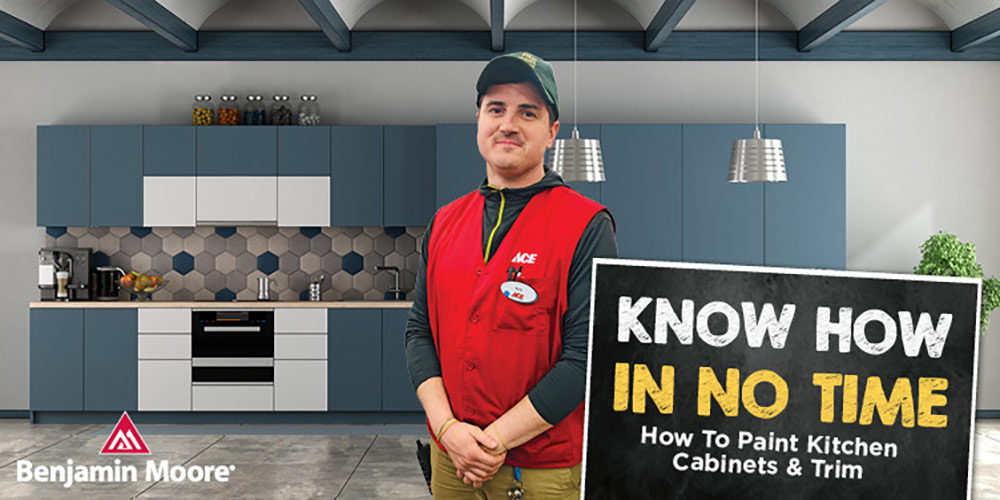
Paint Kitchen Cabinets & Trim
Achieve a top-notch cabinetry paint job and the desired high-end finish you want. The breakthrough waterborne technology of ADVANCE® offers an alkyd-like finish without the messy cleanup and high-VOC content of conventional oil paints. Proper surface preparation, priming, and the right application conditions can make repainting kitchen cabinets a success.
Recommended Materials:
ADVANCE can be applied with a variety of applicators:
- Custom-blended nylon/polyester brush
- Roller
- Airless spray gun
Step-by-Step:
Step 1: Know the Surface
With proper preparation, you can use ADVANCE to paint most cabinet surfaces, including:
- Hardwoods, such as oak, cherry, mahogany, maple, etc.
- Formica® laminate and other High-pressure surface materials
- Fabricated woods
TIP: For best results, apply a primer coat and two finish coats. Additional top coats may be needed depending on the substrate and the specific finish you or your customers wish to create.
Step 2: Preparing Cabinets for Painting
First, remove cabinet doors, drawers, shelves and all hardware to make the preparation and application processes as easy as possible.
- Surfaces to be painted must be clean, dry, and free of dirt, dust, grease, oil, soap, wax, scaling paint, water soluble materials, and mildew.
- Remove any peeling or scaling paint and sand these areas to feather edges smooth with adjacent surfaces.
- Glossy areas should be dulled by sanding.
TIP: If you are planning a spray application, cover countertops, appliances and floor surfaces with paper or plastic, and create a fully enclosed workroom using plastic sheeting. Consider using protective gear, including masks, eyewear, and special ventilation units.
Step 3: Priming Cabinets
Proper primer selection and application are as important as your final coat. Benjamin Moore offers a comprehensive selection of primers for every situation. For best results on wood surfaces, use ADVANCE® Interior Alkyd Primer tinted to the approximate finish coat. If the cabinetry requires a specialty primer for extra adhesion or more robust stain blocking, ask your local Benjamin Moore retailer.
- Wood surfaces: ADVANCE Waterborne Interior Alkyd Primer (790) tinted to the approximate finish coat color
- Laminates: Fresh Start® High-Hiding All Purpose Primer (046)
- Do not use lacquer-based primers or undercoaters, as they can impede how ADVANCE adheres to the surface of the cabinets.
TIP: After your primer coat has dried completely, use 220-grit paper or finer and sand all surfaces lightly. Focus closely on areas that may have drips or pools, such as inside corners and anywhere two flat areas meet.
Step 4: Painting with ADVANCE
Extra ventilation in the work area is necessary under humid or cooler conditions to facilitate faster drying time, especially when paint is applied over sealed, hard, non-porous surfaces.
Spray Application: For spray application, ADVANCE sprays slightly thicker than latex, yet thinner than conventional oils. We generally recommend using an airless spray gun designed for painting cabinets or furniture, as indicated in the TDS. Spray a thin, even coat on all surfaces, paying special attention to edges and corners. Keep a steady pace and try not to go back over areas you have previously coated.
Brush Application: It’s important to apply ADVANCE with a premium Benjamin Moore nylon/polyester brush. Natural-bristle brushes absorb water and hinder even coverage. Work from top to bottom of each piece, first painting across the grain of wood surfaces, then tipping off in full, even strokes with the grain. Paint cabinet doors and other two-sided pieces in a horizontal position so ADVANCE can level out completely. Make sure the paint is dry to the touch before turning pieces and painting the other side.
TIP: It’s important to sand between coats to ensure a smooth final finish. After your first coat has dried completely, sand all surfaces using fine-grit paper, taking extra care to smooth out any drips or pools that have formed in corners or elsewhere. Vacuum and wipe with denatured alcohol to remove all dust.
Step 5: Cleanup and Return to Service
Unlike with traditional alkyds, cleanups with ADVANCE are fast, easy and solvent-free. Soap and water is all you need.
TIP: Give the final coat several days to cure before reassembling the cabinets and returning to service.




